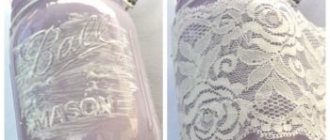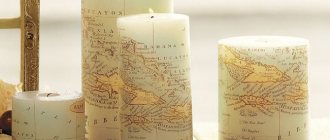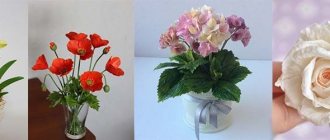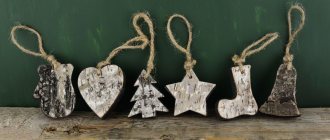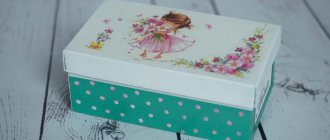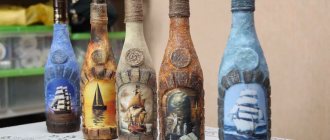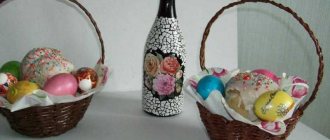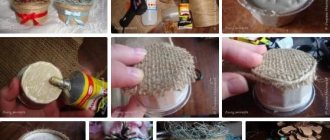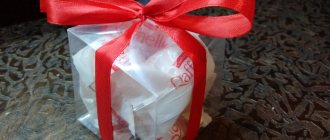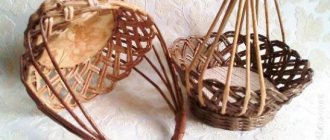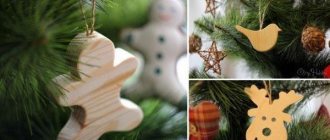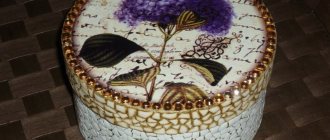Your own style, your own style, an interior design unlike anyone else. And you can create all this with your own hands, turning the kitchen or living room into a cozy corner. Let's play with jars, bottles, old boxes and various unnecessary packaging. Believe me, from all this “garbage” you can create small works of art. Turn on your imagination and give yourself and the world hand-made masterpieces. You will feel how much warmth such crafts will bring into your life, create a special mood and add harmony to your way of life. Let's start with the simplest thing - decoupage of a glass jar.
Decoupage glass jar
Don't rush to throw the glass jar in the trash. Let's create a kitchen masterpiece out of it.
What we need for work:
- beautiful napkin;
- acrylic paint or acrylic primer;
- PVA glue;
- decoupage varnish;
- polyethylene file;
- brush;
- sponge;
- alcohol or alcohol-containing liquid.
First you need to treat the surface with an alcohol-containing liquid, then the paint will lie smoothly. Then use a sponge to apply a thin layer of primer or PVA glue. Choose a paint color to match the decoupage napkin. For a deeper shade, cover the jar with acrylic again. Let the jar dry between coats. You can go over the surface with fine sandpaper to remove any unevenness.
And then the most interesting and creative activity. We take a napkin with a beautiful pattern, a flower, a picture of a children’s theme, and carefully tear off the drawing. We work not with scissors, but with our hands. Separate the colored layer with the pattern from the two white layers. We do this very carefully.
Place a piece of napkin on the file, pattern down, and lightly spray it with water. We try to smooth out all the irregularities, folds and bubbles with a soft brush. We tilt the file and let the excess water drain.
Place the napkin (along with the file) on the jar and carefully smooth out the design. After this, the file can be removed. Again we smooth the fragment of napkin on the jar with a damp brush and then cover the image with decoupage varnish. This is the most painstaking part of the work.
When the napkin dries, you can add another layer with a pattern (then the applique will be more saturated). If desired, you can paint the surface with patterns and elements of vegetation.
At the end of the work, we cover the dried surface with decoupage varnish, it is advisable to apply several layers. Be sure to dry each layer of varnish; this will give the vessel smoothness and protection from moisture.
You can decoupage coffee cans, decorate baby food jars, and use pretty bottles and any glassware.
Large jars are good for storing cereals, and smaller jars are good for storing spices. They will not only decorate your kitchen, but also create a unique atmosphere of comfort and celebration.
Materials
Various materials are used for primer:
- composition of "Tikkurila Otex";
- acrylic paints (usually the primer is made white, but if aging methods are used), dark or bright contrasting colors are used; after sanding individual areas, the primer becomes visible;
- ready-made artistic primer;
- aerosol paints (they are convenient for decorating plastic and glass);
- varnish-adhesive for dark surfaces.
It does not matter what composition is used to prepare the surface, it is important that it adheres tightly to the surface.
Adhesive compositions:
- PVA, for thick napkins and paper it is diluted 1:1;
- dissolved gelatin (it is soaked until it swells in ¼ of the recommended volume of liquid, then, stirring, heated in a water bath until completely dissolved);
- paste (starch is brewed in small portions, the composition dries out quickly and forms lumps);
- egg white, under no circumstances should it be beaten so that it remains transparent;
- adhesive stick (used only for paper and thick napkins);
- ready-made types of wood glue;
- composition for decoupage;
- diluted acrylic varnish (add ½ part water to 1 part varnish);
- liquid wallpaper glue (it is diluted to the consistency of kefir);
- special glue for glass (moisture resistant, but takes a long time to dry);
- clear nail polish.
When dry, any glue should become transparent so that the design is clearly visible through it.
The varnish is applied in several layers; it is needed to protect the picture from damage. It is necessary to take into account that there is high humidity in the kitchen. Types of varnish coatings:
- acrylate or acrylic compositions for various water-based surfaces (yacht varnish adds yellowness);
- nitro varnish is persistent, but working with it requires personal protective equipment, it is poisonous;
- glassy varnish is used for plastic jars, it is flexible and does not crack when the surfaces are bent;
- water- or oil-based polyurethane compounds used for the finishing layer;
- Tsapon is the only varnish that is not afraid of high temperatures;
- aerosol Mod podge;
- parquet varnish.
Vintage style or distressed
If you love vintage and antique items, you can do the work using the craquelure technique. To do this, you need to purchase craquelure varnish.
Master class in aging techniques:
- We treat the base of the jar with an alcohol-containing solution and apply the first layer of acrylic paint. It is this that will then shine through the cracks created by the varnish. We dry the workpiece.
- We do the second coating with craquelure varnish. We also dry the surface.
- Apply a third layer of paint of a different color.
When this entire “sandwich” dries, you will see a network of cracks on the surface of the jar, like in old paintings by Flemish painters.
This is a very beautiful technique. You can combine both techniques: decoupage and craquelure in one work and create a coffee set from jars and a tray.
Decoupage tin can
Don’t rush to throw away baby food containers. It has wonderful airtight plastic lids. Tin can decoupage, a master class of which we will now look at, will undoubtedly decorate your kitchen.
Materials and tools
To work we will need:
- alcohol or alcohol wipe;
- acrylic primer and paint;
- PVA glue;
- beautiful napkin;
- decoupage varnish;
- brushes, sponge or piece of foam rubber;
- and, most importantly, a good mood!
Master Class
- Degrease the surface of the jar with alcohol or an alcohol wipe.
- Apply acrylic primer in a thin layer. Let's dry it.
- Use a sponge to cover the surface of the container with white acrylic paint.
- Let's cut out a fragment of the picture, for example, a bouquet of roses. Separate the 2 bottom layers of the napkin from the colored one.
- Carefully place the drawing and cover the surface of the napkin with PVA glue (from the center to the edges). Try to smooth out all bubbles and wrinkles. Let the layer dry.
- Let's paint the product with a second layer of acrylic paint. You can take pink, gray or beige. It's better to work with a sponge. Around the drawing we make the color deeper and more intense. This will add depth and volume to the bouquet. Let the paint dry.
- Cover the entire jar with 2-3 layers of varnish.
- You can glue thin lace along the top edge.
Voila! Your beauty is ready. You can put hairpins, small items for a sewing machine, combs and even candies there.
Decoupage of plastic jars
You can always find empty plastic cans and bottles in any home. You can also keep your child and yourself busy with useful creative activities. Let's play with objects together and create a beautiful thing.
We will prepare the following tools and materials:
- clean plastic jar or bottle;
- scissors;
- acrylic primer;
- paints or varnishes;
- three-layer napkin or decoupage card;
- accessories for decoration;
- decoupage glue or PVA glue;
- fixing varnish.
- We clean the surface from grease and dust using alcohol or an alcohol-containing liquid.
- Cover the entire surface with primer.
- Apply two layers of white paint.
- We place a fragment of a napkin or decoupage card on the surface of the jar and carefully apply PVA glue. Try to do everything slowly so that the surface becomes smooth and free of bubbles. Let the layer dry.
- Apply a second layer of paint to match the napkin.
- You can draw an outline of individual elements that complement the central design.
- We decorate the jar with sparkles, shells, and lace. This is your field of creativity.
- We cover all this splendor with decoupage or any other varnish that you have at home.
This is interesting: How to Cut a Chicken into Pieces
We rejoice together with the children in beautiful interior items!
Decorating the container
During this time, you can resolve the issue with illustrations for decoupage. Napkins with certain elements and motifs are selected and carefully cut out . The layers are separated from the elements, leaving only the first of them, on which the image is applied.
It is recommended that you first draw a plan diagram by hand on a sheet of paper, from which it will be clear where and what elements will be located exactly.
Napkins are created either independently, using a printer (black and white and color), or using special templates; they can be found in specialized stores. In the first case, you can create the desired plot depending on your imagination, but in accordance with the interior and stylistic direction of the kitchen. The choice of various applications in online stores can be found very large, there are images of very good quality, it is possible to choose something even for the most sophisticated taste.
Decoupage of enamel dishes
Often our enamel dishes begin to deteriorate: the enamel comes off, the design wears off from washing, and the color becomes dirty. Rust appears in some places. What to do?
We turn on creativity, roll up our sleeves, prepare a place for “dirty” work and dive headfirst into the process. And so that our loved ones do not interfere, we involve them in this sacred rite.
Tools and materials for utensils:
- rust converter;
- alcohol;
- primer-enamel for rust;
- white enamel;
- napkins, prints, decoupage cards;
- alkyd-urethane varnish;
- brushes
Let's start processing the container:
- If there is rust on the dishes, be sure to treat them with a rust converter. Repeat the treatment several times, otherwise the corrosion will go further and the entire decor will be ruined.
- Degrease the surface of the dishes and remove excess rust converter.
- We prime the surface with a special primer-enamel for rust. Apply three layers. Sand after each layer.
- We paint the surface with white enamel.
- Prints, napkins and decoupage cards are glued to urethane varnish. It grips well on flat surfaces.
- For the background and drawing, you can use the same primer-enamel for rust, mixed with acrylic paints to the desired color.
- Additional surface decoration elements can be used.
- We sand the surface well and apply alkyd-urethane varnish. It is self-leveling and self-leveling.
Working with enamel and metal utensils is more labor-intensive, but the effect will not be long in coming. You can update your pots, jars, teapots and decorate your kitchen with exquisite dishes.
Decor for the festive table
Low-cost, but at the same time excellent decor for the holiday table, will be crafts from glass jars in which you can place small flower arrangements.
To create them you will need:
- Acrylic paint of a suitable color;
- Several identical medium-sized glass jars;
- Soup plate.
We pour paint into the plate to the level we need for the pattern on our vases. Then carefully lower the jar into the paint.
To create a wave-like pattern, alternately tilt it a little and lift it back, scrolling around its axis. Then you need to put them on a surface previously covered with film to dry.
When the paint has set, turn the jars upside down so that it also dries well. After complete drying, place small flowers in them and you can decorate the table.
We recommend reading:
Crafts from isolon - a manufacturing master class, nuances of working with the material and step-by-step instructions on how to make a craft (85 photos)- Crafts from saw cuts: stylish and beautiful options for decorating the garden and interior with your own hands (130 photos)
- Crafts from toothpicks - interesting ideas, manufacturing examples and the best crafts for children (120 photos)
Coffee decoupage: original jars for storing food
Many housewives make sure that bulk products are stored neatly in beautiful jars. Coffee beans require special storage, so it is very important to create the right conditions.
Jars for various grains and cereals can be made to suit your home interior. Housewives can show their imagination and involve the whole family in creating jars. Children are always delighted with various crafts.
Of course, stores now have a wide range of storage containers. But they do not differ in design, and things of the same type often look sparse. To create an unusual jar, you don’t have to buy a glass craft jar. If you love coffee, use coffee cans. You can decorate them in all possible ways. Let's look at some of them.
Winter craft in a jar
To create “magic” from an ordinary, unremarkable jar, we will need:
- pharmaceutical alcohol and glycerin;
- toy Christmas tree, sparkles, decorations;
- PVA glue.
We create a craft in a glass jar for the New Year like this:
- remove the lid of the jar and pierce it (the lid should be made of plastic);
- insert the Christmas tree into the hole and glue it;
- when the glue dries, it’s time to decorate the Christmas tree - we put toys and bows on it;
- now you need to add glycerin and pharmaceutical alcohol; dilute them in water, put one tablespoon of each substance per liter of water;
- add glitter to the resulting solution;
- We place the Christmas tree in our jar and put the lid on as tightly as possible.
Now let's turn over the New Year's craft in a glass jar to enjoy the magical picture.
Alcohol and glycerin increased the density of water, so the sparkles do not immediately fall on the Christmas tree; New Year's dances are performed around it.
You can “place” any toys in a jar, for example, a car.
Coffee can decoupage ideas
To create interesting coffee jars, you can use several options for materials:
- Textile;
- Paints;
- Polymer clay;
- Handy items (grains, twigs, pebbles);
- Mixed materials (involves all of the above components).
They often use scrap materials and decorate the product with plastic inserts, old toys and other things. If you have extra things that can be used in the art of decoupage, be sure to use them.
Master class on creating a decorative coffee can
Coffee beans are almost always sold in paper bags, so many housewives pour it into more suitable containers. This is the right decision, since coffee requires careful storage. This way the taste of the future drink will retain its aroma. The first master class involves creating a jar for cereals and grains using paints. To create a decorative element you will need:
- Glass coffee jar;
- Acrylic paints;
- PVA glue for children;
- Sponge;
- Glass varnish (if the surface with paint is small, you can also use colorless nail varnish);
- Brush;
- Hairdryer and scissors (to complete the composition).
Stages of creating a decorative container:
- In order for paints and varnish to adhere well to the surface of the glass and last a long time, the jar must be degreased. Don't hesitate at this stage, even if you think the jar is perfectly clean, handprints will still leave marks on it. To remove them, use alcohol or nail polish remover. Thoroughly wipe the entire surface, including the lid of the jar, with a cotton swab.
- The second item is to select the drawing style. It can be a romantic rustic style or an urban classic, royal with ornaments or picturesque with a forest. Choose a design that matches the style of kitchen you can depict.
- The first layer is the background layer. It is better to use a white background, it harmoniously combines with many decorative elements, and it is better to apply the main pattern on it (it will be clearer this way). When depicting the sky and the greenery of the trees, you can use a sponge, so the jar will get a romantic style.
- If you don't have artistic skills, use the decoupage technique. To do this, apply a napkin with a beautiful pattern to the jar and apply 1/3 PVA diluted with water on top, hold it for several minutes, and then remove the light layer of the napkin. The drawing remains on the can. In this case, it is very important to coat only the part of the napkin that you want to apply (i.e. with the pattern).
- It’s an interesting option to depict an ornament with children, this will create not only a useful jar, but also a memorable souvenir. You can make plastic inserts from old toys, just be sure to make sure there are no sharp protruding parts.
- To create a spring ornament, you can use only a sponge and paints, draw a design, and after it dries, cover the work surface with varnish. You can attach polymer clay products (flowers, leaves, curls).
- If you want a royal style, use the colors: dark blue, gold and white. It is assumed that there is a lace trim on the top of the jar: it is coated with glue and lace is applied. If you have extra old brooches at home, be sure to use them.
Themed crafts for the holidays
Very often there is a need to interestingly decorate children's or other holidays in a certain theme.
Original ideas for crafts made from small jars depicting your favorite characters or holiday symbols will come to the rescue. For example, by painting a jar with orange paint and drawing eyes and a mouth on it, we get an excellent decor for Halloween.
And for a Minions-themed party, you can prepare jars of sweets in the shape of these heroes. To do this, paint the jars (suitable for baby purees) yellow with acrylic paint and leave until completely dry.
At this time, cut a thin strip of black cardboard long enough to wrap the container. Then glue the strip approximately in the middle.
We will paste ready-made doll eyes onto it, or you can make them yourself from cardboard or colored paper. Let's draw a smile with a black marker or acrylic paint and as a result we will get wonderful crafts from children's jars.
Coffee decoupage
To create a decorative coffee can in an urban style, prepare:
- PVA glue;
- Coffee beans;
- Glass jar;
- Jute rope;
- Lace;
- Acetone;
- Napkin with a picture of a cup;
- Varnish;
- Paints.
The creation process is very simple:
- Degrease the jar as in the previous version.
- Apply beige background paint.
- Coat a napkin with glue and apply to the surface.
- Remove any remaining paper and process the jar.
- Glue the grains beautifully on the top, lace on the bottom.
- Cover the entire surface of the jar with varnish and let dry for several hours.
This is interesting: Cleaning Gold at home
In this way, you will not only get a neat coffee jar, but also an excellent gift, carefully made with your own hands. You can't exactly recreate a drawing, but coming up with a new one is much more interesting. Experiment and you will achieve great heights in the art of decoupage.
Drink can lamp
To make crafts from beer cans with your own hands, you need to choose something simple and practical, for example, a bottle. Aluminum is a fairly soft material that can be easily processed, so you can cut it into the desired shape.
The top and bottom of the can are cut off, and holes are made in the form of a pattern on the side parts with a nail. You don’t have to make a pattern, but it makes the product more interesting when light penetrates the holes.
The secret to easily creating a pattern is simple: place a piece of foam plastic inside the jar so that a nail or awl can more easily pierce the jar and not go too deep.
You can make several such lampshades to decorate a whole garland with them. In this case, small products are made so that the lighting is not too bulky. You can take one large jar and make a lampshade. Some people leave the bottom in place, cutting off only the top. A candle is placed inside, and the lampshade easily turns into a flashlight or candlestick.
Features and technique of decoupage of a tin can
Ideas for decorating tin cans using the decoupage technique is the best solution for designing kitchen utensils, it is also practical and unique.
Reasons to choose the tin can decoupage technique:
- Ease of doing the work yourself;
- Fascinating handicraft technique;
- Cheapness of available materials for manufacturing;
- Using iron baby food jars or glassware.
It is important to remember before you start decorating that the surface must be disinfected and thoroughly cleaned; this can be done with a solvent. In order for the pattern to lie beautifully, the surface is in most cases covered with acrylic paint; the tone will become more even.
When choosing the external decor for a jar, you can choose a more voluminous option in the form of coffee beans or choose to use napkins with pictures.
The use of napkins is convenient, as they fit perfectly on the surface of the jar, displaying clear lines of the design. Their advantage over simple photographic paper is that there is no need to hide defects with more massive decor.
The main thing is to choose the right napkins
To decorate jars using the decoupage technique, you should not use cellulose or bamboo table paper single-layer napkins with a pattern. They are very thick, fluff falls off, they absorb a large amount of adhesive, and take a long time to dry.
Some change color due to glue or varnish. For decoupage, you only need paper napkins, but not all of them: loose ones, made from recycled materials, spread out on the adhesive layer. It is better to choose three-layer ones; only the top, colored layer is used.
Experts, based on personal experience, recommend three-layer napkins:
- the Norwegian company Sagen Vintage Design, they make small batches and use motifs from hand-drawn postcards of the last century;
- Craft Premier, where you can find pictures of Gzhel;
- Merlot, use a variety of drawings: children's toys, still lifes, flowers, fruits and berries.
Rice Paper+Design, Shabby roses, POL-MAK 10, Russian 33x33 stick well. In specialized departments they purchase pictures for decoupage and print any design on thin paper. Four-layer sanitary handkerchiefs are also used for decoration.
Ideas for decoupaging coffee cans in different styles
The simplicity and ingenuity of tin can decoupage styles exceeds all expectations. You can choose absolutely any style. It all depends on the mood and the occasion.
But the most popular are:
- Shabby chic;
- Holiday decoration ideas: for March 8 or the New Year, Christmas ideas will also come in handy;
- Provence;
- Vintage.
The most common decor option is shabby chic ideas; only variations on a vintage or Provence theme can be better than this.
It is the shabby style that will look like aging of interior items, including tin cans. Romantic notes on the jars in the form of applying the decoupage technique are all kinds of flowers and landscapes.
Vintage style is used to decorate iron cans or glassware using napkins, the main idea of which is to convey the era of past centuries. Provence, as a type of French decor, is depicted in the form of drawings with vegetation and baskets of fruit, in addition to animals and portraits. This style is interesting due to its rustic motifs in the interior of kitchens; pastel colors will complement the harmonious atmosphere.
Science buffs may enjoy decoupage techniques, in which drawings are applied in the form of an aged atlas or world map. You can refresh and make a thing better by decorating the decoupage in a festive New Year theme or in accordance with the date, it can be an image of a person or thematic drawings.
Candlesticks made from tin cans
For your garden, you can make original decor from tin cans, which will create a special atmosphere and comfort in the evenings. To implement this idea, you need a hammer and a sharp nail.
First, let's draw a pattern or inscription using a marker directly on the jar. If you plan to leave it in its original form without painting, then you need to print a stencil with dots.
Let's take a hammer and, while hammering in a nail, make several holes to create a pattern. Place a candle inside and that’s it, the candlestick is ready. It can be painted, hung on the veranda or placed on the table - in any case, such a decoration will not go unnoticed.
Detailed master class on decoupage of a tin can
For lovers of handmade techniques, using decoupage will be a simple way to transform an old item and breathe new life into it. The topic of decorating iron cans is very relevant, since families with children have a lot of baby food containers left over. The material is cheap, so it wouldn’t be a shame to throw it in the trash if things go wrong.
Tin jars appear in the kitchen and from grocery stores, selling peas or corn, pasta and all kinds of pickles.
From such tin utensils you can make not only a jar for spices, but also a beautiful piece of furniture, a box. To help beginners, a master class on decoupage of iron cans is presented.
All necessary materials for work:
- The iron can itself;
- Selected napkin for applying a pattern to the surface;
- Special glue;
- Varnish for coating the can;
- Acrylic paint is required;
- Oil paints if necessary;
- For disinfection, alcohol solution;
- Scissors for cutting out the design;
- Brush for applying paint.
- Alcohol or any other alcohol-containing liquid to degrease the jar;
- A microfiber cloth for wiping away defects during the work process.
The work begins with the fact that the decorative item, in this case a tin can, must be thoroughly washed and dried. Using the existing alcohol solution, the surface is wiped, after which acrylic paint is taken, most often white, which will look harmonious with the pattern of the adhesive napkin. To prevent the material of the can from being visible, you need to paint it at least twice, and possibly three times. The selected design can be cut out, or it can be torn out of a napkin, which usually consists of several layers.
Having first applied the glue and then the napkin itself, the decoupage artist checks for bubbles in order to push them all out. After waiting for the finished product to dry, you can then coat it with varnish or additionally use oil paints for a specific style.
The napkin is glued separately to each layer, and as you work it will be clear how many are needed. Thus, the desired decoupage technique is achieved and visually it corresponds to the theme and place in the interior.
Beautiful vases
During the warm season, glass vases will serve as a “shelter” for fresh flowers.
In winter, you can put pine or spruce Christmas branches in them; they will fill your home with a festive mood.
In addition to the jar, you will need an old newspaper and acrylic paint (at least 3 colors):
- Place the glass container upside down on a newspaper spread.
- We pour acrylic of some color onto the bottom.
There is no need to worry about paint running down the edges of the jar. Otherwise it won't be possible to do it anyway.
- On top of paint of one color we pour material of a different shade. This way the colors will mix. We continue until we have used all the colors of acrylic that we have.
- Do not touch the vase for at least 2 days, let it dry.
After just a few hours, our jar will feel dry to the touch. But this is only to the touch - the inner layers of paint have not yet dried and may leak. That's why you need to wait a few days.
A beautiful decorated vase is ready.
Eggshells in decoupaged iron cans
Ideas and themes of decoupage can be realized by applying eggshells, especially since this does not require a lot of available materials. It is enough that the surface is properly cleaned and glue is applied.
It is important to glue the eggshells sequentially, section by section, and not cover the entire surface with glue at once.
When making decoupage, you can combine eggshells with three-layer napkins for decoration.
Stages of work on decoupage with eggshells:
- First, the shell should be properly prepared; it should be taken from a fresh egg, cleaned of the inner film and well dried;
- The jar must have a flat surface that is cleaned of dirt and disinfected;
- After applying glue to the base, pieces of shell are placed on top of it, imitating the desired pattern;
- It is important to glue the shell before the glue has time to dry;
- You can fix the eggshell with your fingers to ensure a tight fit to the surface;
- The gaps between the elements of the shell are adjusted by each at will, depending on the pattern.
When the decoupage process is already at the final stage, you can see the overall picture of the design and complement it by adding colors of paint. The shell holds tightly if everything is done correctly. Decoration with coffee decoupage can thus be applied to both an iron jar and a glass one.
This is interesting: How to Confess Love to a Guy
Organizers for storing small items
DIY crafts made from tin cans are remarkable because they have high strength and capacity. In addition, even a child can handle the material.
The standard size of the jar is ideal for making a pencil holder or organizer for storing office supplies.
Such a container can be painted with any paint, even very thick, and not just acrylic and spray paint. When all the layers are dry, you can begin further decoration.
If you don’t want to decorate the jar with anything other than color, you can leave this laconic design.
Very often they take a tall tin can and stick several small ones in a cascade to its side, for example, from pate or fish. Pencils and pens are placed in a large container, and paper clips, an eraser, a sharpener, and buttons are placed in a small container.
You can put both cutlery and kitchen utensils in the container. The main thing is to choose the optimal height correctly so that objects do not outweigh the jar and it does not tip over.
Decoupage of coffee cans: interesting ideas and master class
join the discussion
Share with your friends
Drinking a cup of coffee in the morning is not just about enjoying a delicious, invigorating drink. For many people, such an event is almost a sacred act. It is recommended to decorate it at a decent level, with all the necessary surroundings. The following should be present: a beautiful teapot, a capacious Turk, exclusive dishes and, of course, a spectacular jar where ground coffee is stored. You can make it beautiful, with original colors and textures with your own hands.
Preparation for decoupage
A master class on creating an original coffee product is simple. You will need any glass container that is easy to find. You can also decoupage coffee cans. Although glass jars are usually more affordable, it is better to use them for work. You will also need acrylic paint; it is non-toxic and ideal for this type of operation. The paint can be taken in several colors, for example, brown, white and yellow. You will also need:
- brushes (wide and thin);
- napkins with your favorite images;
- scissors;
- knife, blades;
- cotton swabs;
- acetone or paint thinner (to remove old glue);
- coffee beans;
- supercement glue “Second”;
- glue gun;
- rope;
- figures cut out of plywood (heart, coat of arms of your favorite city, ideas may vary);
- cotton rag.
The process should begin by removing the label. This can be done simply: put the jar in a pan of boiling water, “boil” it there for about 10 minutes. After this, the label can be easily scraped off with a knife or blade, and the remaining glue can be removed using a rag soaked in acetone or solvent. After completing the operation, it is recommended to wipe and dry the jar.
After the preparatory manipulations, white paint is prepared, brown is added to it, this will be more in harmony with the coffee theme.
Flavors
Such a craft will not only bring aesthetic pleasure, but will also bring practical benefits - it will help relieve stress. Rosemary and chamomile are especially soothing.
To make flavors using the oil of these plants, you simply need:
- Pour 60 ml of clean water and the same amount of vodka into a small jar with a thin neck.
- Then add 25 drops each of rosemary and chamomile oil.
- Shake the resulting flavoring thoroughly.
- Insert a spray nozzle into the glass container.
The flavor is ready.
Now we will always have a pleasant soothing blend of rosemary and chamomile at hand.
